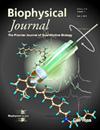5'-tRNAHisGUG片段:具有反向序列激活见解的首选内源性TLR7配体
IF 3.2
3区 生物学
Q2 BIOPHYSICS
引用次数: 0
摘要
toll样受体7 (Toll-like receptor 7, TLR7)是TLR家族的关键成员,在先天免疫中起着关键作用,是一个有吸引力的治疗靶点。然而,目前合成的TLR7激动剂通常具有显著的毒性,因此需要更安全的天然替代品。我们最近的研究发现tRNAHisGUG的5'-片段(5'-HisGUG)和tRNAValCAC/AAC (5'-ValCAC/AAC)是有效的,天然存在的TLR7激活剂。虽然已知内源性rna如5'-HisGUG可以激活TLR7,但它们相互作用的分子细节尚不清楚。为了解决这个问题,我们进行了分子动力学模拟和MM/GBSA结合自由能分析,以研究与合成激动剂相比,这些RNA片段如何与TLR7结合。我们的研究结果显示,5'-HisGUG, 5'-ValCAC/AAC和反向序列(5'-HisGUG- rev)表现出很强的结合亲和力,比合成激动剂具有更高的能量优势。自由能波动表明内源性RNA配体表现出更大的构象变异性,这可能有助于它们的激活电位。值得注意的是,5'-HisGUG-Rev有效激活了TLR7,增强了细胞因子mRNA的表达。对比分析表明,单独的结合亲和力并不能直接预测激活,强调了TLR7激活过程中强相互作用和构象灵活性的重要性。这些发现表明5'-HisGUG是一种有潜力的天然TLR7激活剂,具有潜在的治疗应用。本文章由计算机程序翻译,如有差异,请以英文原文为准。
5'-tRNAHisGUG fragment: A preferred endogenous TLR7 Ligand with reverse sequence activation insights.
Toll-like receptor 7 (TLR7), a key member of the TLR family, plays a pivotal role in innate immunity, making it an attractive therapeutic target. However, current synthetic TLR7 agonists are often associated with significant toxicity, highlighting the need for safer, naturally occurring alternatives. Our recent research identified 5'-fragments of tRNAHisGUG (5'-HisGUG) and tRNAValCAC/AAC (5'-ValCAC/AAC) as potent, naturally occurring TLR7 activators. While endogenous RNAs like 5'-HisGUG are known to activate TLR7, the molecular details of their interaction remain unclear. To address this, we performed molecular dynamics simulations and MM/GBSA binding free energy analysis to investigate how these RNA fragments engage with TLR7 in comparison to synthetic agonists. Our results revealed that 5'-HisGUG, 5'-ValCAC/AAC, and reverse sequence (5'-HisGUG-Rev) exhibit strong binding affinities, with higher energetic favorability than synthetic agonists. The free energy fluctuations suggested that endogenous RNA ligands display greater conformational variability, possibly contributing to their activation potential. Notably, 5'-HisGUG-Rev effectively activated TLR7 and enhanced cytokine mRNA expression. Comparative analysis suggests that binding affinity alone does not directly predict activation, emphasizing the importance of both strong interaction and conformational flexibility in TLR7 activation. These findings position 5'-HisGUG as a promising natural TLR7 activator with potential therapeutic applications.
求助全文
通过发布文献求助,成功后即可免费获取论文全文。
去求助
来源期刊

Biophysical journal
生物-生物物理
CiteScore
6.10
自引率
5.90%
发文量
3090
审稿时长
2 months
期刊介绍:
BJ publishes original articles, letters, and perspectives on important problems in modern biophysics. The papers should be written so as to be of interest to a broad community of biophysicists. BJ welcomes experimental studies that employ quantitative physical approaches for the study of biological systems, including or spanning scales from molecule to whole organism. Experimental studies of a purely descriptive or phenomenological nature, with no theoretical or mechanistic underpinning, are not appropriate for publication in BJ. Theoretical studies should offer new insights into the understanding ofexperimental results or suggest new experimentally testable hypotheses. Articles reporting significant methodological or technological advances, which have potential to open new areas of biophysical investigation, are also suitable for publication in BJ. Papers describing improvements in accuracy or speed of existing methods or extra detail within methods described previously are not suitable for BJ.
 求助内容:
求助内容: 应助结果提醒方式:
应助结果提醒方式:


